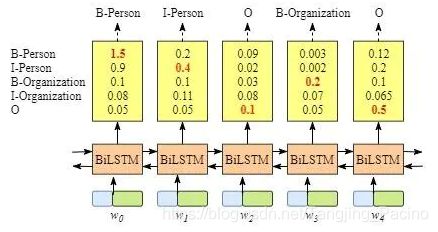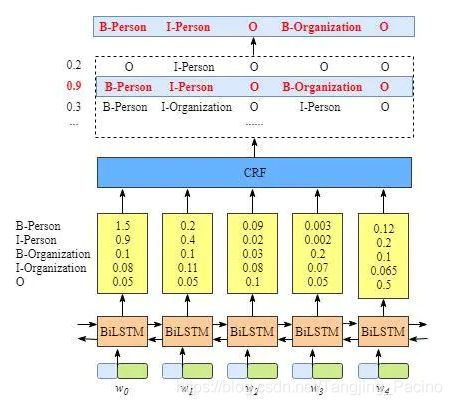学习笔记:基于BI-LSTM+CRF实现命名实体识别(Pytorch实现)
写在前面:
本文根据自己的理解介绍Pytorch实现Bi-LSTM+CRF的官方代码的实现过程和原理,初入NLP如有不对请大牛指正。
原文链接:https://pytorch.org/tutorials/beginner/nlp/advanced_tutorial.html#bi-lstm-conditional-random-field-discussion
代码下载链接:
先不讲原理,来看看代码的实现过程
一、main函数(包括准备数据、训练、验证结果)
1.首先准备好数据
词语(输入):将训练句子中出现的所有词语放入一个字典中,字典的key为该词语,value为编号。
词性(输出):同理将标签tag也放入一个词典,由于tag比较少就直接写了。
if __name__== '__main__':
START_TAG = ""
STOP_TAG = ""
EMBEDDING_DIM = 5
HIDDEN_DIM = 4
#准备数据,每个词语机器对应的词性
training_data = [(
"the wall street journal reported today that apple corporation made money".split(),
"B I I I O O O B I O O".split()
), (
"georgia tech is a university in georgia".split(),
"B I O O O O B".split()
)]
#将准备好的词语放进词集,通过word_to_ix将每个词转换成数字
word_to_ix = {
}
for sentence, tags in training_data:
for word in sentence:
if word not in word_to_ix:
word_to_ix[word] = len(word_to_ix)
#词性转换成数字
tag_to_ix = {
"B": 0, "I": 1, "O": 2, START_TAG: 3, STOP_TAG: 4}
#创建模型和优化函数
model = BiLSTM_CRF(len(word_to_ix), tag_to_ix, EMBEDDING_DIM, HIDDEN_DIM)
optimizer = optim.SGD(model.parameters(), lr=0.01, weight_decay=1e-4)
# Check predictions before training
#训练前查看一下数据在模型中的预测(标注)结果
with torch.no_grad():
precheck_sent = prepare_sequence(training_data[0][0], word_to_ix)
precheck_tags = torch.tensor([tag_to_ix[t] for t in training_data[0][1]], dtype=torch.long)
print(model(precheck_sent))
# Make sure prepare_sequence from earlier in the LSTM section is loaded
#训练
for epoch in range(
300): # again, normally you would NOT do 300 epochs, it is toy data
for sentence, tags in training_data:
# Step 1. Remember that Pytorch accumulates gradients.
# We need to clear them out before each instance
model.zero_grad()
# Step 2. Get our inputs ready for the network, that is,
# turn them into Tensors of word indices.
sentence_in = prepare_sequence(sentence, word_to_ix)
targets = torch.tensor([tag_to_ix[t] for t in tags], dtype=torch.long)
# Step 3. Run our forward pass.
loss = model.neg_log_likelihood(sentence_in, targets)
# Step 4. Compute the loss, gradients, and update the parameters by
# calling optimizer.step()
loss.backward()
optimizer.step()
# Check predictions after training
#训练后查看结果
with torch.no_grad():
precheck_sent = prepare_sequence(training_data[0][0], word_to_ix)
print(model(precheck_sent))
# We got it!
2.训练数据。
训练的过程我们放到后面,可以暂时理解为一个黑盒,该神经网络可以将我们传入的句子输入其对应的词性。
3.查看训练前的预测结果
结果为(tensor(2.6907), [1, 2, 2, 2, 2, 2, 2, 2, 2, 2, 1]),可以看到根据我们定义的tag,可以看到预测的标签与原本定义下的[0, 1, 1, 1, 2, 2, 2, 0, 1, 2, 2]并不一样。
训练后的结果为(tensor(20.4906), [0, 1, 1, 1, 2, 2, 2, 0, 1, 2, 2])与结果相同。
with torch.no_grad():
precheck_sent = prepare_sequence(training_data[0][0], word_to_ix)
precheck_tags = torch.tensor([tag_to_ix[t] for t in training_data[0][1]], dtype=torch.long)
print(model(precheck_sent))
这里有一个prepare_sequence方法,其实就是在此表里去查找该句子中所有词对应的序列
例如,我们将第一个句子“the wall street journal reported today that apple corporation made money”11个词语以此放入词集,取出来也应该是对应的[ 0, 1, 2, 3, 4, 5, 6, 7, 8, 9, 10],再返回tensor格式tensor([ 0, 1, 2, 3, 4, 5, 6, 7, 8, 9, 10])
同理第二个句子在词集中对应的数字为[11, 12, 13, 14, 15, 16, 11]
def prepare_sequence(seq, to_ix):
idxs = [to_ix[w] for w in seq]
return torch.tensor(idxs, dtype=torch.long)
到这里如果你不深究该神经网络的实现原理,其实你已经可以写自己的命名实体识别代码了,将自己的数据集准备成对应的格式即可。下面我么继续研究神经网络的搭建。
二、数据准备好后,我们需要搭建神经网络。
1.先讲一下搭建流程
下图为一个Bi-LSTM词性标注的过程,w0,w1…表示句子里面的字,经过biLSTM处理,输出每个字对应每个标签的分数,我们将最大数值表示对该字预测的标签。

上述方法的缺点就是,会有得分与真实值不符的标签出现,因为Bi-LSTM只能预测文本序列与标签的关系,而不能预测标签与标签的关系。比如我们常知道的名字后面跟动词,而不能是动词+动词。

所以我们将Bi-LSTM的输出作为CRF的输入,计算出一个得分最高的标注序列。

2.神经网络搭建代码(这里只给出结果,后面一步步分析)
class BiLSTM_CRF(nn.Module):
def __init__(self, vocab_size, tag_to_ix, embedding_dim, hidden_dim):
super(BiLSTM_CRF, self).__init__()
self.embedding_dim = embedding_dim
self.hidden_dim = hidden_dim
self.vocab_size = vocab_size
self.tag_to_ix = tag_to_ix
self.tagset_size = len(tag_to_ix)
self.word_embeds = nn.Embedding(vocab_size, embedding_dim)
self.lstm = nn.LSTM(embedding_dim, hidden_dim // 2,
num_layers=1, bidirectional=True)
# Maps the output of the LSTM into tag space.
self.hidden2tag = nn.Linear(hidden_dim, self.tagset_size)
# Matrix of transition parameters. Entry i,j is the score of
# transitioning *to* i *from* j.
self.transitions = nn.Parameter(
torch.randn(self.tagset_size, self.tagset_size))
# These two statements enforce the constraint that we never transfer
# to the start tag and we never transfer from the stop tag
self.transitions.data[tag_to_ix[START_TAG], :] = -10000
self.transitions.data[:, tag_to_ix[STOP_TAG]] = -10000
self.hidden = self.init_hidden()
def init_hidden(self):
return (torch.randn(2, 1, self.hidden_dim // 2),
torch.randn(2, 1, self.hidden_dim // 2))
def _forward_alg(self, feats):
# Do the forward algorithm to compute the partition function
init_alphas = torch.full((1, self.tagset_size), -10000.)
# START_TAG has all of the score.
init_alphas[0][self.tag_to_ix[START_TAG]] = 0.
# Wrap in a variable so that we will get automatic backprop
forward_var = init_alphas
# Iterate through the sentence
for feat in feats:
alphas_t = [] # The forward tensors at this timestep
for next_tag in range(self.tagset_size):
# broadcast the emission score: it is the same regardless of
# the previous tag
emit_score = feat[next_tag].view(
1, -1).expand(1, self.tagset_size)
# the ith entry of trans_score is the score of transitioning to
# next_tag from i
trans_score = self.transitions[next_tag].view(1, -1)
# The ith entry of next_tag_var is the value for the
# edge (i -> next_tag) before we do log-sum-exp
next_tag_var = forward_var + trans_score + emit_score
# The forward variable for this tag is log-sum-exp of all the
# scores.
alphas_t.append(log_sum_exp(next_tag_var).view(1))
forward_var = torch.cat(alphas_t).view(1, -1)
terminal_var = forward_var + self.transitions[self.tag_to_ix[STOP_TAG]]
alpha = log_sum_exp(terminal_var)
return alpha
def _get_lstm_features(self, sentence):
self.hidden = self.init_hidden()
embeds = self.word_embeds(sentence).view(len(sentence), 1, -1)
lstm_out, self.hidden = self.lstm(embeds, self.hidden)
lstm_out = lstm_out.view(len(sentence), self.hidden_dim)
lstm_feats = self.hidden2tag(lstm_out)
return lstm_feats
def _score_sentence(self, feats, tags):
# Gives the score of a provided tag sequence
score = torch.zeros(1)
tags = torch.cat([torch.tensor([self.tag_to_ix[START_TAG]], dtype=torch.long), tags])
for i, feat in enumerate(feats):
score = score + \
self.transitions[tags[i + 1], tags[i]] + feat[tags[i + 1]]
score = score + self.transitions[self.tag_to_ix[STOP_TAG], tags[-1]]
return score
def _viterbi_decode(self, feats):
backpointers = []
# Initialize the viterbi variables in log space
init_vvars = torch.full((1, self.tagset_size), -10000.)
init_vvars[0][self.tag_to_ix[START_TAG]] = 0
# forward_var at step i holds the viterbi variables for step i-1
forward_var = init_vvars
for feat in feats:
bptrs_t = [] # holds the backpointers for this step
viterbivars_t = [] # holds the viterbi variables for this step
for next_tag in range(self.tagset_size):
# next_tag_var[i] holds the viterbi variable for tag i at the
# previous step, plus the score of transitioning
# from tag i to next_tag.
# We don't include the emission scores here because the max
# does not depend on them (we add them in below)
next_tag_var = forward_var + self.transitions[next_tag]
best_tag_id = argmax(next_tag_var)
bptrs_t.append(best_tag_id)
viterbivars_t.append(next_tag_var[0][best_tag_id].view(1))
# Now add in the emission scores, and assign forward_var to the set
# of viterbi variables we just computed
forward_var = (torch.cat(viterbivars_t) + feat).view(1, -1)
backpointers.append(bptrs_t)
# Transition to STOP_TAG
terminal_var = forward_var + self.transitions[self.tag_to_ix[STOP_TAG]]
best_tag_id = argmax(terminal_var)
path_score = terminal_var[0][best_tag_id]
# Follow the back pointers to decode the best path.
best_path = [best_tag_id]
for bptrs_t in reversed(backpointers):
best_tag_id = bptrs_t[best_tag_id]
best_path.append(best_tag_id)
# Pop off the start tag (we dont want to return that to the caller)
start = best_path.pop()
assert start == self.tag_to_ix[START_TAG] # Sanity check
best_path.reverse()
return path_score, best_path
def neg_log_likelihood(self, sentence, tags):
feats = self._get_lstm_features(sentence)
forward_score = self._forward_alg(feats)
gold_score = self._score_sentence(feats, tags)
return forward_score - gold_score
def forward(self, sentence): # dont confuse this with _forward_alg above.
# Get the emission scores from the BiLSTM
lstm_feats = self._get_lstm_features(sentence)
# Find the best path, given the features.
score, tag_seq = self._viterbi_decode(lstm_feats)
return score, tag_seq
代码比较长,但是真正搭建神经网络的函数只有Init。我们一个一个方法分析。
首先回到我们刚才的训练步骤,代码如下
神经网络训练的基本步骤:
1.创建一个神经网络,即我们自己定义的神经网络(上面的代码)
2.定义优化函数,这里使用SGD
3.开始训练,这里将两个句子训练300次
训练基本步骤:
(1)生成预测值(一般可以写在训练步骤,这里写在了神经网络定义步骤)
(2)计算预测值与真实值的差值Loss
(3)梯度归零、反向传递、参数更新(基本操作)
model = BiLSTM_CRF(len(word_to_ix), tag_to_ix, EMBEDDING_DIM, HIDDEN_DIM)
optimizer = optim.SGD(model.parameters(), lr=0.01, weight_decay=1e-4)
for epoch in range(
300): # again, normally you would NOT do 300 epochs, it is toy data
for sentence, tags in training_data:
# Step 1. Remember that Pytorch accumulates gradients.
# We need to clear them out before each instance
#梯度归零
model.zero_grad()
# Step 2. Get our inputs ready for the network, that is,
# turn them into Tensors of word indices.
#准备数据,将句子和转换成tensor格式的数字
sentence_in = prepare_sequence(sentence, word_to_ix)
targets = torch.tensor([tag_to_ix[t] for t in tags], dtype=torch.long)
# Step 3. Run our forward pass.
#,将训练集和目标值传入模型并计算得到差值
loss = model.neg_log_likelihood(sentence_in, targets)
# Step 4. Compute the loss, gradients, and update the parameters by
# calling optimizer.step()
loss.backward()
optimizer.step()
上面所有方法中,神经网络的入口为loss = model.neg_log_likelihood(sentence_in, targets)
def neg_log_likelihood(self, sentence, tags):
# 这里进来sentence的是词典编码tensor([ 0, 1, 2, 3, 4, 5, 6, 7, 8, 9, 10])
# 比如本项目的训练语句为"the wall street journal reported today that apple corporation made money"。通过lstm输出的的特征,表示训练语句中每个词语对应每个标签的得分,如第一行第一个数字代表the这个单词对应标签0(即“B”)的得分,同时该特征将作为CRF的输入,即发射矩阵。
# tensor([[-0.1079, -0.0006, 0.2340, -0.0838, 0.1052],
# [-0.0326, -0.1672, 0.0877, -0.0408, 0.1419],
# [-0.2220, -0.1824, 0.1869, -0.0737, 0.0579],
# [-0.0658, -0.1156, 0.0281, -0.0952, -0.0408],
# [-0.1824, 0.1028, -0.1790, 0.1596, -0.0385],
# [-0.0917, 0.0357, 0.0443, -0.0058, 0.1017],
# [-0.2441, -0.0490, 0.0046, 0.0394, 0.1387],
# [-0.2499, -0.0145, -0.0439, -0.0399, 0.2532],
# [-0.0973, -0.0133, 0.0963, 0.0926, 0.0216],
# [0.1057, 0.1108, -0.0436, 0.0596, 0.0328],
# [-0.0921, -0.0858, 0.1399, -0.1722, -0.0161]],
# grad_fn= < AddmmBackward >)
feats = self._get_lstm_features(sentence)
# 这里是将Bi-lstm得到的发射矩阵传入进来,计算得到一个得分,再返回最大的得分值,即CRF的功能
forward_score = self._forward_alg(feats)
# 这里计算了目标tag的得分情况
gold_score = self._score_sentence(feats, tags)
# 将得分相见得到差值并返回
return forward_score - gold_score
下面是神经网络的搭建
定义一个LSTM神经网络并初始化其值
def __init__(self, vocab_size, tag_to_ix, embedding_dim, hidden_dim):
super(BiLSTM_CRF, self).__init__()
self.embedding_dim = embedding_dim
self.hidden_dim = hidden_dim
self.vocab_size = vocab_size
self.tag_to_ix = tag_to_ix
self.tagset_size = len(tag_to_ix)
self.word_embeds = nn.Embedding(vocab_size, embedding_dim)
self.lstm = nn.LSTM(embedding_dim, hidden_dim // 2,
num_layers=1, bidirectional=True)
# Maps the output of the LSTM into tag space.
self.hidden2tag = nn.Linear(hidden_dim, self.tagset_size)
# Matrix of transition parameters. Entry i,j is the score of
# transitioning *to* i *from* j.
self.transitions = nn.Parameter(
torch.randn(self.tagset_size, self.tagset_size))
# These two statements enforce the constraint that we never transfer
# to the start tag and we never transfer from the stop tag
self.transitions.data[tag_to_ix[START_TAG], :] = -10000
self.transitions.data[:, tag_to_ix[STOP_TAG]] = -10000
self.hidden = self.init_hidden()
def init_hidden(self):
return (torch.randn(2, 1, self.hidden_dim // 2),
torch.randn(2, 1, self.hidden_dim // 2))
def forward(self, sentence): # dont confuse this with _forward_alg above.
# Get the emission scores from the BiLSTM
lstm_feats = self._get_lstm_features(sentence)
# Find the best path, given the features.
score, tag_seq = self._viterbi_decode(lstm_feats)
return score, tag_seq
上面有一个_viterbi_decode方法,这个方法的作用是计算出序列的可能性的值。即tensor的那个得分,并返回该得分的路径。
def _viterbi_decode(self, feats):
backpointers = []
# Initialize the viterbi variables in log space
init_vvars = torch.full((1, self.tagset_size), -10000.)
init_vvars[0][self.tag_to_ix[START_TAG]] = 0
# forward_var at step i holds the viterbi variables for step i-1
forward_var = init_vvars
for feat in feats:
bptrs_t = [] # holds the backpointers for this step
viterbivars_t = [] # holds the viterbi variables for this step
for next_tag in range(self.tagset_size):
# next_tag_var[i] holds the viterbi variable for tag i at the
# previous step, plus the score of transitioning
# from tag i to next_tag.
# We don't include the emission scores here because the max
# does not depend on them (we add them in below)
next_tag_var = forward_var + self.transitions[next_tag]
best_tag_id = argmax(next_tag_var)
bptrs_t.append(best_tag_id)
viterbivars_t.append(next_tag_var[0][best_tag_id].view(1))
# Now add in the emission scores, and assign forward_var to the set
# of viterbi variables we just computed
forward_var = (torch.cat(viterbivars_t) + feat).view(1, -1)
backpointers.append(bptrs_t)
# Transition to STOP_TAG
terminal_var = forward_var + self.transitions[self.tag_to_ix[STOP_TAG]]
best_tag_id = argmax(terminal_var)
path_score = terminal_var[0][best_tag_id]
# Follow the back pointers to decode the best path.
best_path = [best_tag_id]
for bptrs_t in reversed(backpointers):
best_tag_id = bptrs_t[best_tag_id]
best_path.append(best_tag_id)
# Pop off the start tag (we dont want to return that to the caller)
start = best_path.pop()
assert start == self.tag_to_ix[START_TAG] # Sanity check
best_path.reverse()
return path_score, best_path
休息一下,留坑分析公式和方法细节。